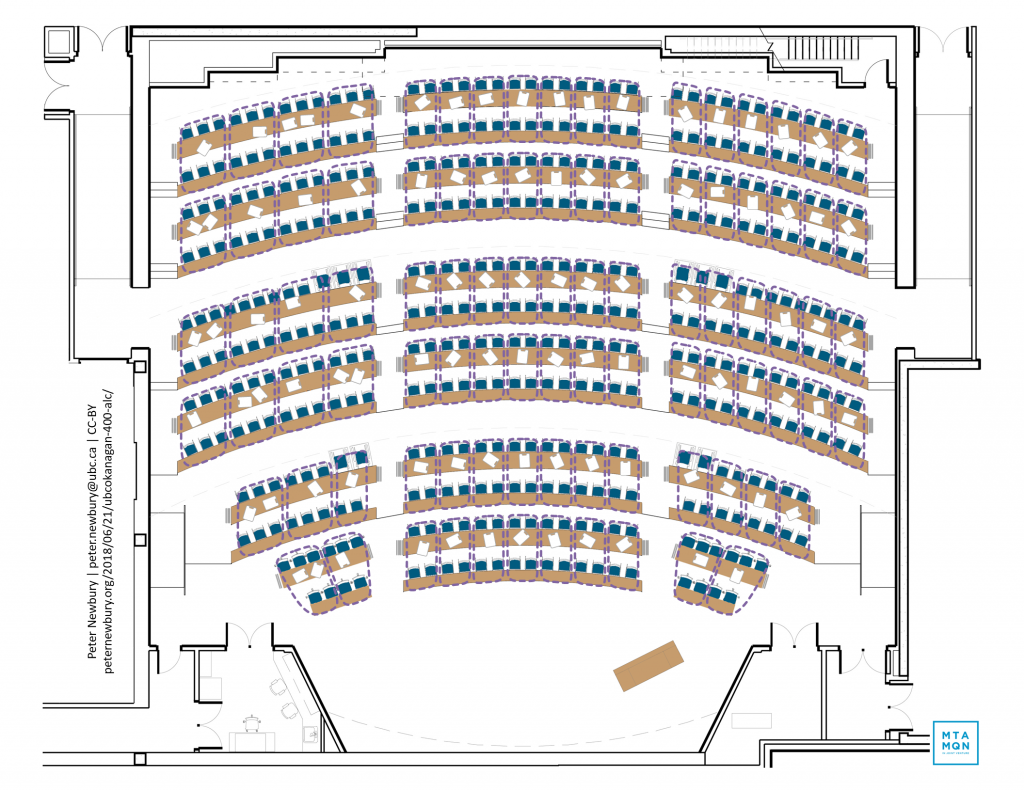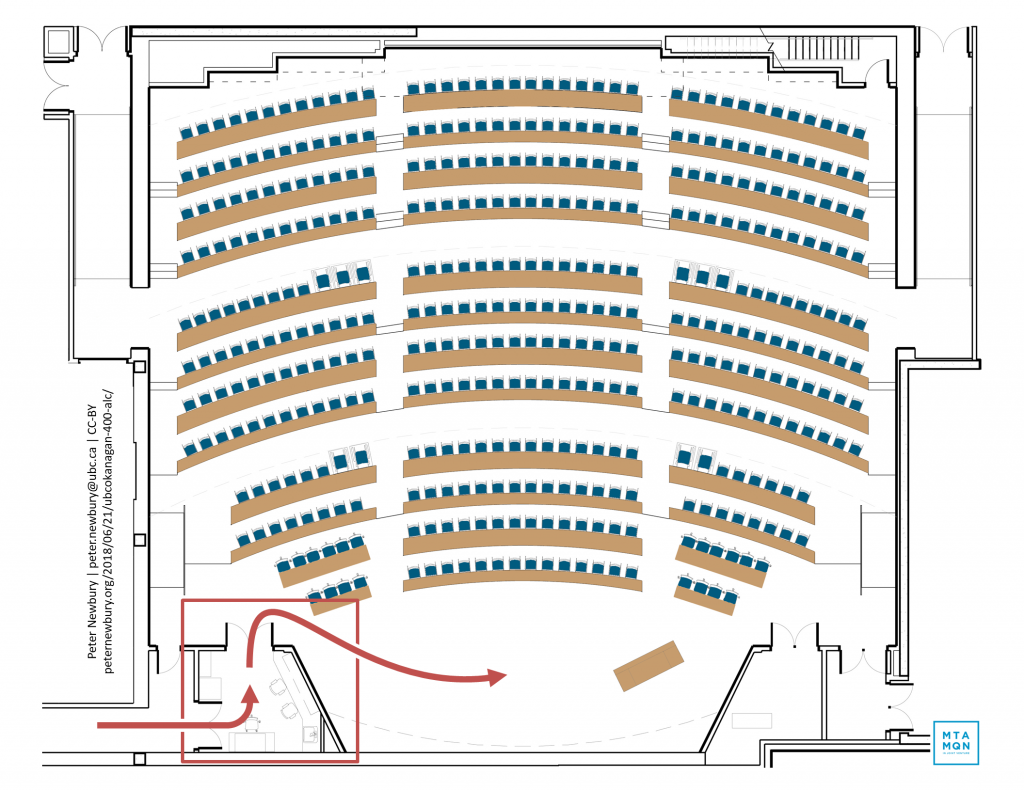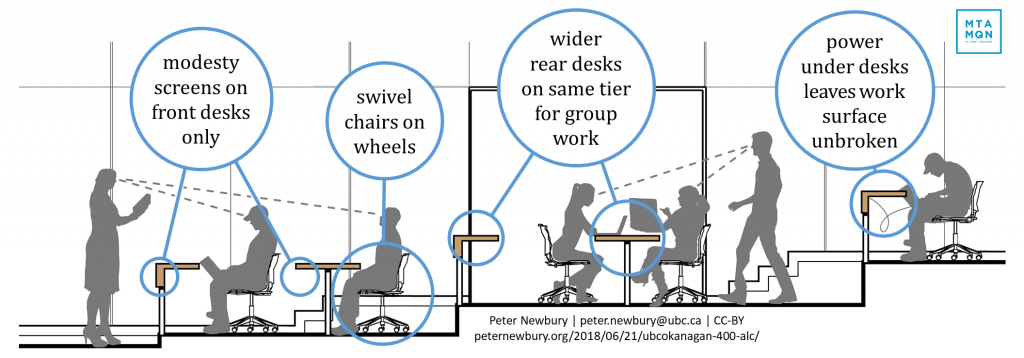Last Fall, the senior staff in my Centre for Teaching and Learning suggested we should take a look at our mission. Other units at UBC Okanagan have been updating their “Mission, Vision, Values” – perhaps to align and synchronize with the new UBC Strategic Plan.
I have to admit, I wasn’t enthusiastic about the “MVV” exercise but one of my Centre colleagues volunteered to take the lead, so we went ahead with focus groups, summaries, drafts, and follow-up discussions.
In the end, I’m really glad we did it. As expected, it bought us all together, helped us identity what we care about, how we want to enact it, and lets our campus partners know what they can expect from us.
Here’s the result, with a description and commentary below.
Mission:
To promote, inspire, and support
excellence, leadership, scholarship, and technologies
in teaching and learning.
Guiding Principles:
- We advocate for and support evidence-informed approaches to teaching and learning.
- We provide ongoing and valuable professional development for all those who teach.
- Our approach is based on respect, inclusion, equity, and compassion.
About the Mission
One of the biggest changes to our mission is what we left out. The mission used to say we’d lead and support teaching excellence, scholarship, and other components of teaching and learning. The new mission very deliberately takes a step back: demonstrating educational leadership is required for merit, tenure, and promotion for a stream of teaching faculty at UBC (and it certainly contributes to promotion of faculty in the research stream.) There are projects and tasks the people in my Centre are entirely capable of leading, like reviewing papers, leading faculty learning communities, or organizing parts of our annual conference. These are excellent opportunities for faculty in the teaching stream to have impact beyond their classrooms, though. So rather that us doing it, we’re promoting these opportunities to our community and then supporting them.
It’s natural and expected that we’ll “promote” and “support” components of teaching and learning. From the focus groups and our own discussions, we recognized something we love to do: “inspire” those in our teaching and learning community. We have the privilege of interacting with a lot of people and projects, so when we’re consulting with course instructors, we can weave exciting and creative opportunities into our discussions. Sometimes that’s all it takes to get a faculty member inspired – it’s not that they’re not creative, curious, or enthusiastic but they just don’t have the time to survey what’s out there.
This promote-inspire-support strategy definitely applies to the scholarship of teaching and learning, too. While there’s nothing stopping Centre staff from writing and publishing SoTL, it’s not required for promotion (none of us are faculty members.) We’re thrilled to spark projects and be co-investigators and co-authors. It’s critical, though, that we support educational research done by faculty members.
One other addition to our mission: the Centre has a strong reputation for supporting learning technologies, like the learning management system, peer instruction / clickers, video capture/integration, etc. Focus group participants were surprised we didn’t mention that in our old mission so it was a no-brainer to add it to the new mission. Well, almost a no-brainer:
- Do we promote, inspire, and support “learning technologies”? No, we don’t need to say “learning”, especially when the mission would say, “…learning technologies in teaching and learning.”
- “technology” or “technologies”? There isn’t just one technology and technologies (plural) gives us more flexibility.
- Wait, do we really “…inspire…technologies…in teaching and learning”? What does that even mean? We decided to let that one thread of the mission slide. Recasting the sentence to eliminate it would make things worse.
One funny thing emerged from our focus groups. The old mission statement talks about supporting teaching and learning excellence, scholarship, and innovation. Some people interpreted that to mean we support
- teaching and learning excellence
- scholarship
- innovation
“Oh, what kinds of innovation do you support?” they wondered. “Um, innovations in teaching and learning.” “Oh, I get it now…”
So, we recast the mission statement to better communicate there are many aspects of teaching and learning that we promote, inspire, and support. This is why you include focus groups in developing these things!
About the Guiding Principles
People typically talk about their organization’s mission, vision, and values. After we were happy with where the our new mission statement was heading, we turned to vision and values. And quickly concluded we couldn’t say much about how we envision the Centre promoting, inspiring, and supporting teaching and learning without a set of values to build from.
Moving on, then, we quickly realized we were all a bit uncomfortable with “values.” Who’s values, the Centre’s? (Can a Centre have values?) And what if someone’s personal values conflict with the Centre’s values – we certainly don’t want to exclude a Centre staff member because their own values are different!
At some point, I said supporting evidence-informed pedagogies has got to be one of the principles we follow. I think that’s when another senior staff suggested we have guiding principles instead of values. Everyone immediately agreed, and all the anxiety and hesitation around “values” disappeared.
So, the first guiding principle was pretty easy:
- We advocate for and support evidence-informed approaches to teaching and learning.
We chose “evidence-informed” rather than “evidence-based” to allow for experimentation and innovation. Limiting ourselves to approaches that have conclusive evidence and peer-reviewed literature would be, well, limiting. We’re definitely not saying anything goes, though. For example, if a faculty member comes to us for help creating a syllabus or curriculum based on their students’ learning styles, we’ll be having a frank conversation with them. The “meshing hypothesis” of learning styles – that an instructor tailor their instruction to individual student’s learning style (visual, auditory, tactile, etc.) – is not a valid pedagogy. Would we refuse to work with that instructor? No. We’d let them know that learning styles are not a valid model, we’d inform them of the valid research about how people learn that shows all students benefit from seeing the same concepts in more than one context, and help them develop lessons where every student sees concepts more than once and in more than one format.
The second guiding principle informs the kinds of programs and support my Centre offers to the university:
- We provide ongoing and valuable professional development for all those who teach.
Here’s some of our thinking:
- this is “professional development” not “training”. It’s not that we train course instructors how to teach – it’s way too complicated for that. Instead, we provide opportunities for these professionals to develop their skills and practices, if they choose to pursue those opportunities.
- I regularly remind my campus colleagues that the Centre is not in the business of providing summative evaluations of faculty members or teaching assistants that are used for tenure and promotion or personnel decisions. We are not the teaching police or teaching judges who declare someone fit (or unfit) for teaching. We’ll provide honest, critical feedback, sure, but for formative purposes: here’s what I see, here are some alternatives, let me help you integrate a more effective approach, and then give you feedback on how you’re doing. To avoid the jargon of “summative” and “formative”, we chose the word “ongoing.”
- I’ve been to enough workshops and, yes, led enough workshops where participants get nothing valuable out of the time and effort they invested in coming and participating. Here’s the typical scenario, something all Centres for Teaching are struggling with: You promote and prepare a 1-hour workshop on learning outcomes. And no one comes. Why not? Because the content has so generic – to not exclude any particular discipline – that nothing is applicable. That’s not a valuable hour. By demanding our programs be valuable, we’re thoughtful about discipline-specific content, even if that means running the same learning outcomes workshop in 4 different Faculties, altering the context and examples to their disciplines. We also work hard to deliver workshops in their spaces – if someone is looking for an excuse to skip the workshop, having to trek across campus in the cold or heat is enough. Our goal is to offer workshops down the hall from their office. We also work hard to collaborate with the Faculty, rather than parachuting in. This includes enlisting the support of the Dean, Director, or Department Head to promote the opportunities. First, when the message comes from the Dean, it carries more weight than spam from the Centre. Second, potential participants know that their Dean, Director, or Department Head recognizes this is a valuable opportunity and it’s a legitimate use of the participant’s time to attend the workshop. This guiding principle helps us make decisions about what, where, when, why, and how to offer workshops. Instead of doing things “the ways it’s always been done,” we question and revise.
Our final guiding principle affirms my Centre needs to treat all those who teach the same way we treat the students in our classrooms:
- Our approach is based on respect, inclusion, equity, and compassion.
I could write a entire blog post about each of the words respect, inclusion, equity, and compassion. Maybe I’ll do that someday. In the meantime, here are a few thoughts that drove us to select these values.
- Nothing gets my hackles up like deliberate disrespect for students. Punching down, starting from an assumption that students are dishonest or lazy, intolerance of anything but full and unwavering attention. I think it’s easier to identify disrespectful actions, so I need my team to be vigilante about being disrespectful to our colleagues.
- Everyone in higher education knows how complex titles and ranks can be. As soon as we try to list people invited to participate in an event, it gets real messy, real fast. Students may talk about their “professors” but I can’t invite “professors” to an event. Does that include assistant and associate professors? What about Instructors or Senior Instructors? What about Sessionals, Adjuncts, Post-docs, and Teaching Assistants? What about staff members who coordinate labs or the curriculum / program maps? To be as inclusive as possible, we talk about “course instructors” and aim our programs at “all those who teach.” We’ll use specific titles and ranks only when necessary (like a peer mentoring program for professors and a teaching credential program for teaching assistants.)
- We need to be compassionate with our colleagues and the complicated lives they lead. If we’re running a series and a participant has to miss a session because of, well, life, that’s fine. If workshop participants need to keep their phones handy because there’s a sick kid, fine. Need to eat your lunch during our meeting because this is the only hour you have all day, sure, no problem. I deliberately and honestly express my gratitude that they’re making time to participate in our programs even if, especially if, they can’t fully participate.
- All these values – respect, inclusion, equity, compassion – need to extend to the students in the courses we’re supporting. For example, I struggle to support course instructors who want to implement reading quizzes at the beginning of each class because that’s how they punish students who don’t attend or arrive late. I’m 100% behind reading quizzes as part of a flipped learning model because they help students prepare for class and reward them for that effort.
- This guiding principle means we’re committing to have difficult conversations with course instructors when their teaching practices appear to be disrespectful, to exclude any student, to treat students unfairly, or to show a lack of care.
Making our mission and guiding principles visible
As we were finalizing our mission and guiding principles, I was reading “The Culture Code” by Daniel Coyle. Great book – I highly recommend it for Centre directors and others in leadership / management positions. He tells powerful stories about the importance of making an organization’s mission visible. Not (just) to the public but to the employees. If the employees don’t know what their organization stands for, how can they possibly support it?
That’s why I put our mission and guiding principles on the wall at the front entrance to my Centre. It lets visitors know this is what we stand for and what they can expect from us. More importantly, Centre staff – including me – see this every time we walk in and out. We’re reminded, many times each day, what we stand for and what we expect can from each other and from ourselves.

Was is worth all the effort?
Yes, yes, absolutely yes.
There isn’t a day that I don’t refer to the mission and guiding principles when chatting with Centre colleagues about projects, initiatives, or opportunities we could be involved in. The mission and guiding principles give us a shared language and a simple but powerful tool for evaluating and assessing what we can do to promote, inspire, and support excellence, leadership, scholarship, and technologies in teaching and learning.
If you’re a Centre for Teaching director and you’re thinking about establishing a centre mission, vision, and values, feel free to contact me – I’m happy to elaborate on anything here.

















